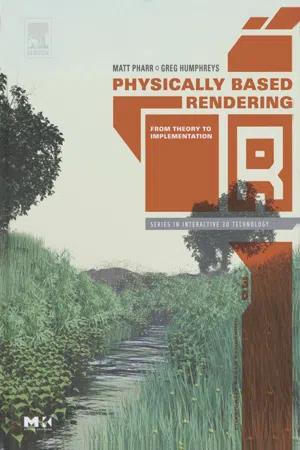
- 1,056 pages
- English
- PDF
- Available on iOS & Android
About This Book
Rendering is a crucial component of computer graphics— the conversion of a description of a 3D scene into an image for display. Algorithms for animation, geometric modeling, and texturing all must feed their results through some sort of rendering process for the results to be visible in an image. Focusing on realistic images, physically based rendering incorporates ideas from a range of disciplines, including physics, biology, psychology, cognitive science, and mathematics. This book presents the algorithms of modern photorealistic rendering and follows step by step the creation of a complete rendering system. As each new rendering concept is introduced it is also shown implemented in code—there is no better way to understand the subtle and complex process of rendering. The code itself is highly readable, written in the literate programming style that mixes text describing the system with the code that implements it. The result is a stunning achievement in graphics education for students, professionals, and researchers.*CD-ROM with the source code for a complete rendering system for Windows, OS X, & Linux—with many examples of images created by the system throughout the 4 color text
*The code and text are tightly woven together through the technique of literate programming with a unique indexing feature that lists all locations of functions, variables, and methods on the page they are first described
*The most complete guide to understanding, designing, and building a rendering system
Frequently asked questions
Information
Table of contents
- Front Cover
- Physically Based Rendering: From Theory to Implementation
- Copyright Page
- Content
- Foreword
- Preface
- CHAPTER 01. INTRODUCTION
- CHAPTER 02. GEOMETRY AND TRANSFORMATIONS
- CHAPTER 03. SHAPES
- CHAPTER 04. PRIMITVES AND INTERSECTION ACCELERATION
- CHAPTER 05. COLOR AND RADIOMETRY
- CHAPTER 06. CEMERA MODELS
- CHAPTER 07. SAMPLING AND RECONSTRUCTION
- CHAPTER 08. FILM AND THE IMAGING PIPELINE
- CHAPTER 09. REFLECTION MODELS
- CHAPTER 10. MATERIALS
- CHAPTER 11. TEXTURE
- CHAPTER 12. VOLUME SCATTERING
- CHAPTER 13. LIGHT SOURCES
- CHAPTER 14. MONTE CARLO INTEGRATION I: BASIC CONCEPTS
- CHAPTER 15. MONTE CARLO INTEGRATION II: IMPROVING EFFICIENCY
- CHAPTER 16. LIGHT TRANSPORT I: SURFACE REFLECTION
- CHAPTER 17. LIGHT TRANSPORT II: VOLUME RENDERING
- CHAPTER 18. SUMMARY AND CONCLUSION
- APPENDIXES
- REFERENCES
- INDEX
- ABOUT THE CD-ROM
- COLOPHON